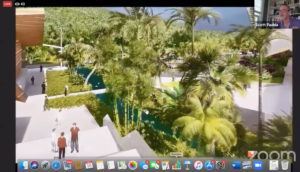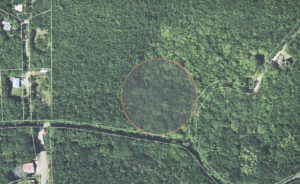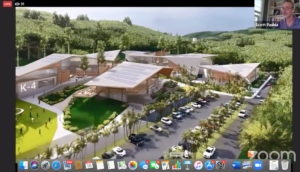
When the Department of Education went on Facebook Live on June 9 and 16, to update the community of its plan to build a new school for St. John, two critical guiding notions jumped out.
First, the school is being designed for a location in Estate Catherineberg and not in Cruz Bay where the only public school on St. John is now located.
Second, the design includes a high school, something many St. John residents have been clamoring for.
The Gifft Hill School, a small private school, expanded to include high school students nearly 20 years ago, but there has never been a public high school on St. John. The 100 or so high school students who attend public school must ride the ferry to St. Thomas, a 15-minute trip each way.
Dionne Wells-Hedrington, chief operations officer for the Department of Education, and Chaneel Callwood-Daniels, the department’s architect assistant, hosted the two Facebook town hall presentations.

They were quick to point out that the 1,000-plus page draft plan for rebuilding the territory’s schools is intended to serve as a framework for what’s to come over the next five years or more, and that community input will be sought throughout the process.
The plan for St. John shows structures to accommodate 260 students in grades K-8, and 200 students in grades 9-12, with room for 200 more. Since only about 100 public high school students currently live on St. John, presumably St. Thomas students would fill out the enrollment.
Much of the June 16 Facebook Live presentation was devoted to explaining the Department of Education’s intention to construct “learning suites” – classroom space designed for more flexible learning options – and to offer more programs in career and technical education. Wells-Hedrington said she expects St. Thomas students would be eager to travel by ferry to attend a brand-new school on St. John with innovative programs.
Further information on the overall design concerns and new programs are online here.

A New STJ School Would Depend on a Land Swap
The process for building a new school on St. John is even more challenging than those for other islands because it depends on a complicated land swap between the Virgin Islands National Park and the Government of the Virgin Islands. Talked about for decades, the land swap has been under serious consideration for more than 10 years.
The Government of the Virgin Islands owns no sites on St. John that are considered appropriate for the construction of a new school. The site of the Julius E. Sprauve School in Cruz Bay has been deemed unacceptable because of its small footprint and its location in a congested area, only a stone’s throw away from a half dozen bars.
Finding a site elsewhere on St. John is tricky because approximately 60 percent of the land on the island is within the boundaries of the Virgin Islands National Park. Changing the boundaries of an established National Park requires congressional approval.
Laurance Rockefeller, who donated much of the land for the VINP, made double certain that his original bequest of almost 5,000 acres would remain undeveloped.
“Everything Rockefeller donated has a reversion clause – if the land is used for anything other than conservation, it goes back to Jackson Hole Preserve,” said island expert Eleanor Gibney. “There are few significantly sized parcels that came into the park after that, that are accessible.”

The chance of finding privately owned land suitable for a school is also unlikely. Property values on St. John are higher than St. Thomas or St. Croix, largely because of proximity to the park, so identifying land that’s affordable for municipal use is unlikely.
However, as the pressing community need for a new school became apparent, National Park Service officials took on the task of finding a parcel that could be used by a school. The idea was to locate a piece of property that was not part of the Rockefeller bequest, that might be traded for a property of equal value owned by the territory.
Rafe Boulon, who served as chief of the V.I. National Park’s Resource Management Division, teamed up with another park official to find a site.
Their goal was to find at least five acres accessible by a major road, that was relatively flat, and did not contain a lot of historic or cultural features.
“We spent a lot of time looking,” Boulon said.
They found only one parcel that met the criteria, a 55-acre tract known as Hammer Farm, or the Bishop property in Estate Catherineberg.
The site is situated at the intersection of Centerline Road and John Head Road, about three miles east of Cruz Bay. Catherineberg contains a number of high-end residences, but is mostly undeveloped, although construction for new businesses has been increasing in nearby estates Susannaberg and Adrian.
The land had been used for farming by Cory Bishop and his wife Ethel May in the 1940s and 50s, according to Gibney.
VINP Superintendent Nigel Fields said, “The NPS purchased the property in 1968, which included a life estate lease from Ms. Ethel May Bishop. She died in Texas in 2006 at the age of 105.”
How Cory Bishop acquired the land is a sordid story involving bigamy, intrigue, court battles and finally his suicide, according to Gibney, who remembers Ethel May living in the house until around 1970.
Steep Topography Presents Challenges
The site generally meets the criteria for a school. The roughly five-acre portion of the Bishop property selected is directly on Route 10 (Centerline Road), which traverses the entire island making it accessible. Although there are extensive ruins of a sugar estate, including a reconstructed stone sugar mill, the school site itself contains little historic value aside from the ruins of the Bishop house.
Finally, the site is relatively flat, but as Boulon pointed out, “relatively flat” means only relative to the rest of St. John, and this is where some problems with the design have emerged.
The plan presented by engineering consultants from the DLR Group during the Facebook Live presentations calls for a school that will have separate clusters of buildings for elementary, junior high and high school students. The classroom clusters will be located up a slope from an administration building, gym, commons building and parking lot. The design also includes a “water feature” to accommodate the flow of water that occurs during heavy rainfall.
Soon after the design was displayed on June 9, Senator-at-large Steven Payne Sr. wrote in to ask where the playing field was. At that point, the presenters acknowledged that although there was an area staked out for a playground for the elementary students, the site did not contain enough flat land to include a playing field.
The presenters added that they might be able to fit in a field on the area planned for a parking lot. This change would require the construction of a multistory parking structure elsewhere.
There is enough land within the 55-acre tract to include a field, Boulon said, but it would be extremely expensive and environmentally destructive to grade the land to be flat enough for a field.
Further, because land owned by the National Park would have to be swapped for a property of equal value owned by the territory, the process of working out a trade becomes more complicated as the amount of land increases.
Park officials have explained in the past that VINP has to carefully consider factors other than the value of the land acquired from the Government of the Virgin Islands. Since the acquisition of property outside the boundaries of the park has to be approved by Congress, the process can become political and take years to finalize.
Moreover, owning property that is not near the park presents logistical and budgetary problems for management, especially as funding for National Parks has decreased steadily over recent years.
More funding may be available soon; on Wednesday the Senate approved the Great American Outdoors Act, which includes $6.5 billion for maintenance of 419 units in the National Park system over the next five years.
Boulon said the Park Service worked with the territory 10 years ago to identify land that it might wish to acquire. At this point, the V.I. government owns two small cays that fall within Virgin Islands National Park boundaries – Whistling Cay and Booby Rock – which NPS officials could consider. In the past, historic sites owned by the V.I. government on St. Croix have been discussed as possible properties to swap.
Boulon said it was up to real estate experts to determine the value of properties being considered for a trade.
During the June 16 Facebook Live meeting, DOE Operations Chief Wells-Hedrington said efforts were now underway to survey the selected site at the Bishop property, and an appraisal would follow before a swap could be negotiated.
VINP Superintendent Fields said, “We continue to productively work with the Government of the Virgin Islands and the Department of Interior’s Office of Insular Affairs with the potential land exchange for the purposes of a new public school on St. John. I expect that we will have multiple opportunities for civic engagement in the coming months.”
Wells-Hedrington, a St. Johnian who has served as principal of two schools on the island, expressed confidence that the process was moving forward: The National Park land would be acquired, the funding would be procured from FEMA and the school would be constructed.
“I want this for my grandchildren,” she said.





